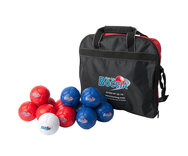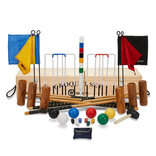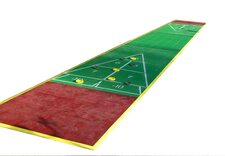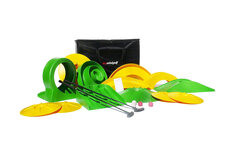The Rules of Petanque or Boule
Petanque is also known as Boule and Bocce. Being a traditional pub game without any national governing body, variations of equipment and rules abound. Where there is doubt, locally played rules should always apply. Please note that 1 metre = 100 cm = 3.28 feet.
See also: Boule / Petanque / Boccia Sets.
Description
The surface of a Petanque pitch can be of any material but thin gravel or sand is most appropriate. The shape can be either a thin strip 25 - 30 m long and 3 m wide or it can just be a large flat area. In the case of a thin strip, lines often define the playing areas:- a line 2m from either end beyond which a boule is out of play and at 5m from either end behind which a player must remain while playing each boule. Each boule is made of metal and is between 7cm and 11cm in diameter, weighing about 800 grams although boules up to 1.3kg are allowed. In singles, each player has three boules, in doubles, each player has three boules and for triples, each player has just two boules. The jack or cochonnet is a small wooden ball around 1 1/2 inches in diameter. Normally a tool called a baguette is used to measure the distance between boules in close situations.
Play
Boules is most commonly played in teams of three. A good team of three will often consist of a "pointeur" who is best at getting the boules nearest to the cochonnet, a "tireur" who specialises in knocking opposing balls out of contention and a "milieu", the captain who is an all-rounder. To begin with players draw lots to decide who goes first. After the first leg, the player who threw the closet boule in the previous leg starts the next leg from the position of the cochonnet. The player who starts the leg must first draw a circle around her feet with a diameter of between 35 and 50 cm. Often, the measuring baguette is used to perform this duty. All players must keep both feet on the ground and within this circle when throwing. The player then throws the cochonnet which must land between 6 and 10 metres away and be at least half a metre away from any obstacle such as the edge of the pitch or a tree. The nearest boule to the cochonnet is always called the "best boule". Each player throws boules until that player runs out of boules or throws a boule that is best boule. Once a player achieves best boule, the next player on the opponents team plays in the same way. When a player runs out of boules, the next player in the same team takes over. Note that the first player therefore always throws just one boule before retiring from the throwing circle because the first boule is automatically best boule. When all the players in a team run out of boules, the opposing team finishes the leg by playing all their remaining boules in an effort to increase their score. Scoring is the same as for Lawn Bowls - the winner of the leg scores one point for each boule that is closer to the target than the opponent's best boule. The team that reaches 13 points first, wins.
These rules are provided by Masters Traditional Games, an Internet shop selling quality traditional games, pub games and unusual games. For general information or for copying and copyright, see our Rules Information page.
Our rules are comprehensive instructions for friendly play. If in doubt, always abide by locally-played or house rules.
Copyright James Masters, 2024. All rights reserved.


























